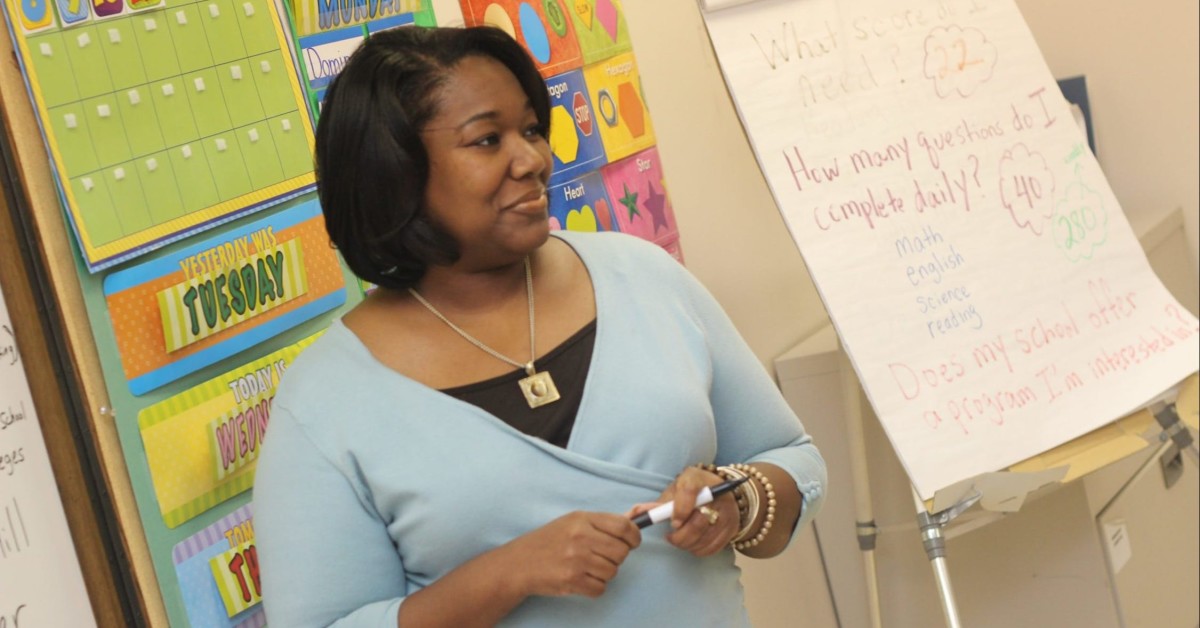
What Do Math Teachers Earn in 2020?
As a math teacher, you may qualify for higher pay [...]

Florida has one of the most dire teacher shortages in the country with over 5,000 unfilled positions. The state, which prided itself on keeping schools open during the pandemic, is struggling to find people to teach. On top of that, teacher pay in Florida has been among the lowest in the nation. The state quickly needs to incentivize people to work.
Enter the teacher residency model. Residencies help those without any teaching experience to earn their education degree and find their way into the classroom quickly—often within a year’s time. Additionally, stipends and scholarships can drastically reduce the cost of teacher residency programs, and Florida is raising teacher salaries across the state to make teaching a more appealing (and feasible) profession.
If you’re wondering how do I enter a teacher residency program in Florida?, continue reading. This article addresses:
Teacher residencies are offered through partnerships between universities or nonprofit educational organizations and schools/school districts, and are modelled after medical residency programs. Instead of holding off teaching in-person toward the end of—or after—graduate school, student teachers spend a whole school year in the classroom (often logging around 1,000 hours of teaching) under the guidance of a mentor teacher.
Typically, residencies consist of either a full or half-day teaching in the classroom—with coursework done at night and on weekends. Student teachers apply the lessons learned through their master’s (or undergraduate) degree coursework on a daily basis, while receiving feedback from their mentor teachers throughout the academic year. In many cases, student teachers work in high-need public or charter schools, and commit to working for a set period of time after their residency at the school is complete.
There are bachelor’s-level residencies and master’s-level residencies, which usually confer a Master of Arts in Teaching (MAT) or a similar graduate education degree.
Residencies typically lead to teaching positions in schools in underserved communities. According to the National Center for Teacher Residencies (NCTR), Title I public schools (federally funding for schools serving low-income students) employ more than 90 percent of graduates from teacher residency programs (the NCTR notes that 94 percent of residents feel prepared for these high-needs environments after graduating). In these schools, oftentimes the teacher turnover rate is abysmal—50 percent higher than average according to the Learning Policy Institute. Teacher residency programs help address this attrition: 86 percent of graduates stayed in their residency schools for at least three years, according to the NCTR. (To be fair, three years is the average amount of time you must teach to keep your residency stipend.)
| University and Program Name | Learn More |
|
New York University:
Master of Arts in Teaching
|
|
|
Merrimack College:
Master of Education in Teacher Education
|
Early research suggests that teacher residencies increase the diversity of people entering this profession and what they are specializing in; improve teacher retention rates; produce effective teachers; and more.
A 2020 annual report by the NCTR found that over 60% of teaching residents identify as people of color, which is 40% higher than the number of new teachers of color entering the field from traditional education degree programs. The organization also notes that more than 20% of residents are specializing in STEM subjects, which is helping to address the dearth of STEM teachers at schools across the country.
The long-term impact of higher retention rates among residency program graduates is that teachers who stick around continue to become more effective teachers. According to the Learning Policy Institute, “teaching experience is positively associated with student achievement gains throughout a teacher’s career.” While improvement is “most steep in teachers’ initial years,” it continues “as teachers reach the second, and often third, decades of their careers.”
Perhaps unsurprisingly, It turns out that pairing a student teacher with a veteran educator is a recipe for classroom success. Researchers at Glass Frog Solutions found that having a teaching resident in the room increased a host teacher’s effectiveness score (TES). So, not only do student teachers learn the skills they need to go on to become great teachers, but their very presence as a mentee positively impacts everyone else in the classroom during the residency as well.
Before diving into the residency programs at individual schools, it’s worth noting that Florida has three alternative pathway programs. Depending on your background, one may be better suited for you than the others. They are:
People with a relevant undergraduate degree (English, history, math, science, foreign language) can apply for a temporary Florida teaching certificate, which creates a faster licensure pathway. For instance, if you studied math in college, you’d be well-positioned to earn a math certificate. From there, students must complete an actual DAC program and pass all other licensure requirements.
EPI programs are designed specifically for career changers and those with a bachelor’s degree in another subject. These programs do not offer as much professional experience as residency programs. Instead, students complete core competency courses, such as technology and education, literacy, and classroom management. You can enter an EPI program with a temporary license.
According to the University of Florida, “A PTO is meant to prepare students majoring in a content area for temporary teacher certification in Florida for that content area.” It’s also open to career changers. Students in this program work for a year in Florida schools and must pass the Florida Teacher Certification Examinations.
Many Florida schools have residency programs, though not all of them are similar. You can find programs at:
The graduate-level Florida Gulf Teacher Immersion Program leads to a five year teaching certificate. The program helps aspiring teachers gain relevant experience, including creating lesson plans and working with students. Those with a STEM background can qualify for an $11,400 tuition scholarship.
The most significant deviation from traditional residency programs is the internship, which only lasts 15 days, though other courses include classroom experience. Students typically take two courses per semester, meaning they’ll need four semesters to complete the requisite eight. This program allows for bachelor’s-holding working professionals to keep their current jobs throughout the program.
Though obviously not a Florida school, NYU offers a Palm Beach-based residency. The program includes around 15 hours of online classes and 40 hours of classroom residency work. Graduates hold a MAT and must agree to work in a partner school for two years after graduation. In return, they earn a residency stipend of around $22,000 and receive full health insurance (medical, dental, and vision).
Rather than teach a whole class, resident interns are Academic Success Tutors who “work with individual students to develop tutoring plans that fit each student’s needs.” They “assess students’ progress and provide feedback to instructional staff.”
UF’s residency program is called Site-based Implementation of Teacher Education (SITE). According to the school’s website, “It’s like your first year of teaching, but with plenty of support along the way.” The program is to help those with a bachelor’s degree in a non-teaching subject earn a one-year master’s degree. Students spend two semesters in the classroom and work with a personal coach.
You’ll complete 36 credits and graduate with a Master of Education (MEd) in Curriculum & Instruction with an elementary education emphasis. That means you’ll be prepared to earn a K-6 teaching certificate. The program lasts three semesters and goes through the summer. There is no stipend, but students can qualify for $1,000 scholarships through the College of Education.
Based in Jacksonville, this residency program prepares graduates for teaching roles in high-need schools. Students complete a MAT in a little over one year (15 months), while apprenticing with a teacher in the school system. Students work in cohorts, which helps create bonds and networks. Students receive a $23,000 stipend to pay for living expenses during the residency and must commit to teaching for three years after graduating. They are guaranteed a job in the Duval County Public Schools system.
USF’s Urban Teacher Residency Partnership Program (UTRPP) is a little different in the sense that it’s designed for undergraduate students in the elementary education Bachelor of Science program. In this two-year program, students work in cohorts. Topics include educational technology and STEM subjects, but you’ll graduate with a K-5 teaching focus.
The residency lasts one year, and you’ll complete more than 2,000 hours of fieldwork. Students receive a $3,200 scholarship each year. Graduates are guaranteed jobs in Hillsborough County.
Remember, each school can have unique requirements, even if they ostensibly offer the same education.
Always be sure to check a school’s requirements before you apply for a program. One of the most common is a bachelor’s degree, often in a relevant subject. NYU’s English track requires applicants to have at least 18 English credits.
It’s common for schools to require a minimum undergraduate GPA, but that can differ. Florida Gulf Coast sets its minimum at 2.75; other programs ask for 3.0 GPAs. NYU requires only that your undergraduate grades be “strong.”
Your school may have program-specific requirements. South Florida applicants must be admitted to the Elementary Education program by fall and “register as a full-time student for five semesters.”
Teacher residency program coursework centers on providing the techniques to succeed in teaching roles. Course titles differ between programs and degrees. Students in the University of Florida MEd program take courses like Integrated Teaching and Learning, Practicum in Diagnosis and Remediation of Reading Difficulties, and Teaching and Learning in Elementary Classrooms.
Students in the University of North Florida secondary education MAT program complete coursework like Foundations of Multicultural and Urban Education, Principles of Instruction and Management, and Special Methods—this coursework is in your area of interest, such as English, science, and foreign language.
It may seem obvious, but specialization can impact what coursework you complete. The titles for each program above look pretty different. One prepares elementary school teachers, the other high school instructors. Elementary programs have a far broader scope than secondary programs, which include subject-specific coursework. Other common specializations are special education and English as a Second Language (ESL).
Teacher residency programs are typically one year, though some are longer. Of course, this doesn’t count your potential post-graduation commitment to the school district, which typically lasts three years.
Florida teachers have long been among the worst-paid in the country. In 2020, the state ranked 49th for teacher pay. According to an article in Capital & Main, “Over the last two decades, Florida teachers pay has decreased 12.5% when adjusted for inflation.” Florida recently decided to put $765 million into raising teacher salaries, which boosted the average starting salary from $40,000 to $46,000.
Though this represents progress, there are still significant issues with Florida teacher pay. More experienced teachers often don’t receive good raises. The most recent Polk County collective bargaining agreement states that bachelor’s degree-holders with ten years of experience earn $45,170 while those with a master’s make $47,351—up from starting salaries of $41,572 and $43,753, respectively. Teachers with 30 years of experience or more earn $62,870 and $65,051, respectively. These numbers may increase soon, but they show that the salary schedule itself does not favor teachers. For comparison, a New York City teacher with a master’s degree and eight years of teaching experience earns $87,510. Of course, that money doesn’t go as far in New York City as it would in parts of Florida.
Once you’ve graduated and become a seasoned teacher, you have several career options, though most require returning to school. You can decide to further your classroom career by earning an educational leadership degree and becoming an administrator. Teaching experience is helpful if your goal is to become a school principal or superintendent.
A residency program can well-position you for these roles if you attend a program with generous stipends or scholarships. Having the financial flexibility to earn another degree is extremely valuable.
(Last Updated on February 26, 2024)
Questions or feedback? Email editor@noodle.com

As a math teacher, you may qualify for higher pay [...]

The 8 Keys to Success,created by the DOE, VA, and [...]

If you're looking to quickly (and inexpensively) earn your MAT [...]

The beauty of online teacher residency programs is that after [...]

Admissions requirements for teacher residency programs are similar to those [...]
Categorized as: Elementary Education, Secondary Education, Education & Teaching